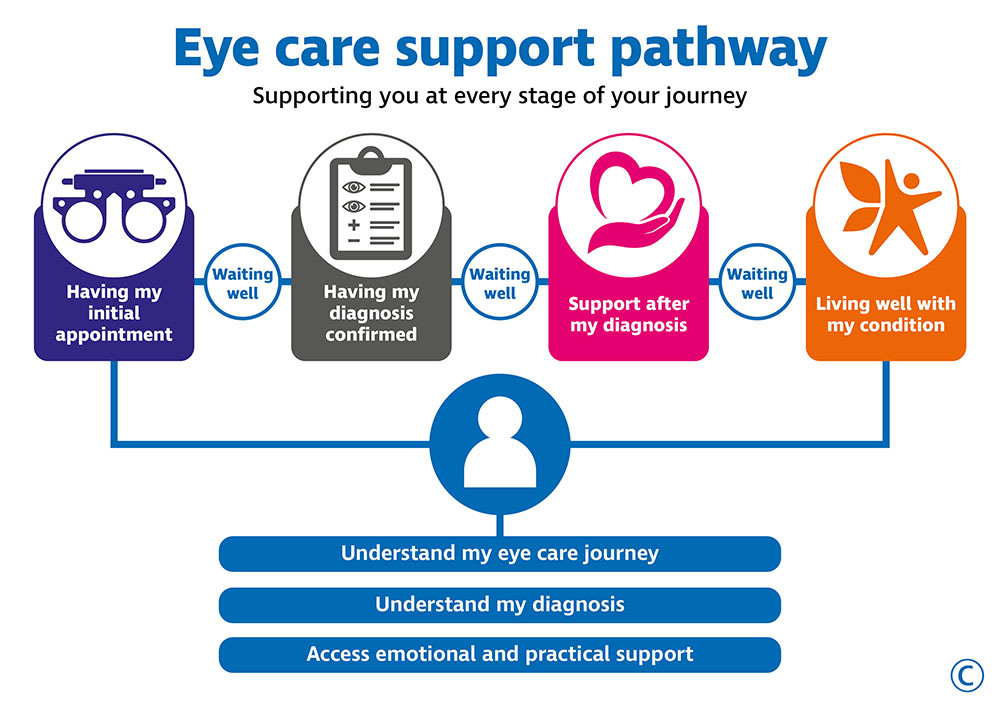- OT
- Professional support
- Optical organisations
- RNIB reveals Eye Care Support Pathway
RNIB reveals Eye Care Support Pathway
More than 20 organisations have supported the UK-wide pathway that aims to ensure patients have timely access to information, advice and support through their eye care journey

Royal National Institute of Blind People (RNIB) has unveiled the Eye Care Support Pathway, a new framework to support people with eye care needs and sight loss, which has gained cross-sector support.
The UK-wide pathway aims to ensure that patients have timely access to information, advice and support throughout their eye care journey.
With the high level of demand on NHS practitioners and eye departments, the RNIB suggested there is a “real need for change,” adding that its research has found people often find it difficult to access eye health and sight loss information, services and support.
RNIB outlined the ambition for the pathway as “from the moment someone realises that ‘something isn’t quite right’ with their sight, through to diagnosis and being able to live confidently – and independently – with their condition, they have access to the information, and support they need.”
The organisation added that patients should be able to actively participate in, and take control of, their eye care journey.
Four key stages
The pathway highlights people’s needs at four stages of their eye care journey:
- Having an initial appointment
- Having a diagnosis confirmed
- Support after a diagnosis
- Living well with a condition.
These stages of the pathway are underpinned by three key needs:
- Understanding my eye care journey
- Understanding my diagnosis
- Having access to practical and emotional support.
More than two years of work has gone into the development of the pathway, which has been informed by research, and the insight of more than 500 people with lived experience and more than 30 bodies representing professionals and patients across the sector.
Senior leaders from organisations in the eye care and sight loss sector gathered in London today (16 November) for the RNIB Collaborate for Good event unveiling the pathway.
Chief executive officer of RNIB, Matt Stringer, said: “We know that the experience of people with eye care needs and sight loss varies greatly across the UK. It’s not acceptable that anyone, regardless of their condition or where they live, does not get the right help and support at the right time.”
Commenting on the encouraging numbers of partners joining the event to work towards “establishing, implementing and delivering” the pathway, Stringer added: “Today is an important milestone, but only the beginning of the work we need to achieve together, bringing everyone together and moving forward to better support people across their eye care journey.”
Supporting the pathway
More than 20 organisations have supported the Eye Care Support Pathway.
This includes the AOP, with policy adviser, Kathy Jones, commenting: "We’re pleased to see this important work that identifies the information and support needs of patients at every stage in their treatment.
“Optometrists are often the first people to spot a problem with a person's eyes, and therefore the first who can provide advice and information as well as reassurance as they refer a person towards the care they will need. The AOP supports anything that will make it easier for optometrists to provide that advice and care."
RNIB shared that the next steps will see the VI Charity Sector Partnership working with NHS and social care bodies, as well as those with lived experience, to implement the Eye Care Support Pathway.
Louisa Wickham, national clinical director for eye care for NHS England, commented: “Success in transforming the way eye care services are provided to meet the increasing demand on the NHS will require the whole sector to transform its approach to improving patient care.
“The Eye Care Support Pathway puts the person at the centre of their eye care and sight loss journey. When the Eye Care Support Pathway is implemented, we must seize the opportunity to truly transform services, empower patients and improve outcomes,” she added.

Rooted in lived experience
The All Party Parliamentary Group (APPG) on Eye Health and Visual Impairment met at the Houses of Parliament on 15 November to discuss the eye care support journey.
Eamonn Dunne, partnerships and projects development manager at the Thomas Pocklington Trust, and Helen Doyle, RNIB strategic engagement manager – NHS, provided an introduction to the Eye Care Support Pathway.
The pathway will focus on supporting patients through four stages of their eye care journey, as well as in periods of waiting between the stages, which Dunne explained: “will improve patients’ outcomes considerably.”
He added: “The Eye Care Support Pathway also offers the opportunity to incorporate and affect the work of BAME Vision, SeeAbility and others, to address the gaps and inequalities faced by people from underrepresented groups, such as ethnically diverse communities and people with learning disabilities and autism.”
Discussing how the pathway was developed with insight from 500 people with lived experience, Doyle said: “The pathway really encapsulates the dedication and commitment to co-producing and co-designing our future eye care services. It is firmly rooted in people’s experiences of living with eye care needs.”
Transforming lives
Highlighting why the new pathway was necessary, he said that it would “change people’s lives, now and in the future.”
“As a united group of professionals from across the eye care sector, you can transform people’s lives,” he said. “We’re on the verge of this, so take the opportunity and keep doing the amazing jobs you’re doing, so people like me don’t have to go through that lottery to see an eye clinic liaison officer.”
The full report can be found on the RNIB website.
The Eye Care Support Pathway
Two years
of work have led to the publication500
people with lived experience provided insight30
organisations representing professionals and patients informed the report20
organisations endorsed the pathwayAdvertisement



Comments (0)
You must be logged in to join the discussion. Log in